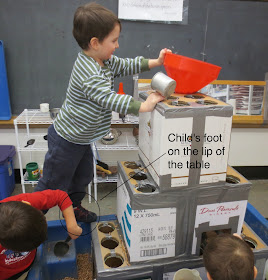Dish soap is squirted over the top of the sponge and water is added to the table. I want enough soap and water to make good suds when the children squeeze the sponge but I do not want so much water that the sponge begins to float.
This year I added a wooden tray to the apparatus. The tray connects the blue water table with another small water table.
The children used the addition of the tray for two main purposes. The first was to hold containers on a different level and to pour and mix into and out of those containers.
The second purpose was to hold the suds the children created. One group got really close to filling the tray with suds.
That amount of suds encouraged some in the group to experience the suds using their sense of smell.
One facet of the sponge is that it fosters physical exploration by the children. Watch the video below to see how the children physically examine the sponges.
As you just saw, the physical exploration including squeezing a small sponge hard, smacking a small sponge on the bottom of the pail, pressing down hard on the big sponge and hand pummeling the big sponge with force.
Here is another instance of physical exploration by the children. In the video below the two children have filled a five gallon pail full of suds. One of the boys decides it is time to dump it. The other boy is all in and even helps to get suds out with his spoon. If you watch to the end you will see the excitement of the venture is palpable.
Imagine what the boys are experiencing. The volume of the five gallon pail of suds is great but the weight is not. How would this have played out if the pail was full of water instead of suds?
Of course there is more than the physical exploration. Some of the exploration verges on the ethereal. Watch this final video to see a child slowly insert a plastic bottle into a full container of suds. The result: a suds fountain.
I almost think the whole operation skirts the threshold of meditation. If you listen to the conversation at the table, you might agree. One of the boys at the table is collecting small sponges. The fountain creator asks the him in the most serene voice: "To make cookies?" He answers: "Chocolate chip cookies."
I usually like my ethereal experiences with a side of chocolate cookies, too.

































